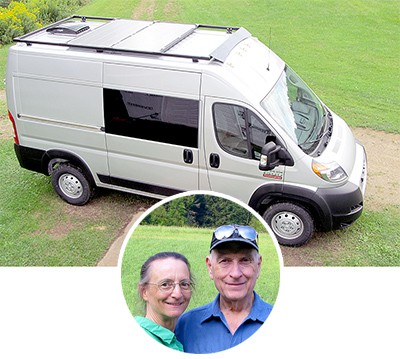
Camping in a van can be an exhilarating experience. You’re able to go wherever you want without the constraints of a small tent or a large RV. However, many people are concerned about how you can get proper rest in such a vehicle.
So, here’s how to sleep in a Transit van. To sleep in your Transit van, you’ll need to choose a good bed and bedding, have proper ventilation, learn how to control the temperature inside of the van, find the right location to park and secure your van for the night.
There are plenty of tips throughout this post to help you stay comfortable when it’s time to stop for the night. A little preparation is all that you will need to sleep comfortably in your Transit van.
Before you start to consider which campground you’ll be staying at, it’s time to think about the bed situation. After all, you can’t just throw down a sleeping bag and go to sleep on the floor of a Transit van. Well, you can, but it’s not going to lead to a very restful night of sleep. Let’s explore some of the options available.
Proper Bed For Sleeping In A Van
Once you’ve picked out the Transit van that you’ll be camping in, you need to start choosing the proper bed setup.
The four essentials of a good bed in a van are the mattress, pillows, blankets, and a frame. Here’s the perfect way to make a comfortable bed in a Transit van:
Check the dimensions of the van’s floor before you buy anything else. If you’re building a bed frame for two people, then you need to purchase a mattress that will fit accordingly. Keep in mind that some vans can have a sideways bed, while others are too narrow.
Douglas fir is a suitable type of wood for building a van bed frame. It’s low-cost, reliable, and its durability and strength would make it a great choice.
Certain lumber also comes treated for mold as well, but be aware that mold can grow on treated lumber also. Additionally, it may not be a good idea to use treated wood in the confines of a van. You’ll need a large sheet of wood to lay on top of the bed frame for complete support.
Once you’ve built the bed frame, choose a breathable mattress that’ll cover the frame completely. The ideal thickness should be about five or more inches to prevent you from feeling the hard wood below. Consider getting a mattress topper for additional support and comfort.
Grab all of the pillows and blankets that you need. Remember that it’s probably going to be much colder in the van than it would be in an insulated house. Even if you have fantastic insulation in your vehicle, it still won’t match a professional installation from housebuilders.
Finally, buy a sheet or a thin blanket that can reach the van floor on any visible sides of the bed. This sheet will act as a cover to keep your valuables underneath the bed out of plain sight from people walking by.
Can You Sleep In A Vehicle Overnight With The Windows Up?
It’s fine to sleep in your vehicle with the windows up as long as the engine isn’t running. You could potentially get seriously injured or even die from carbon monoxide poisoning if you try to sleep with the engine running without rolling the windows down. Check the CDC website for more info on carbon monoxide poisoning.
The only problem you might run into is excess condensation that accumulates on all of the windows. You can help eliminate some condensation by rolling the windows down a bit.
If you’re worried about bugs getting in, there are plenty of bug nets for windows. Bugs and camping go hand-in-hand, but you can keep them away by hooking up a few nets. Proper airflow is always the best way to get an ideal amount of oxygen and keep condensation to a minimum.
We have a post “11 Ways to Stop Condensation When Sleeping in a Van” that will give you tips on how to avoid condensation.
Another issue to deal with when sleeping in a van with the windows up is how hot it is. If it’s over 80 degrees outside, you could get heatstroke, even if it’s dark out. Always roll the windows down a little bit if you’re going to be sleeping in your van on a hot night.
Remember, as stated above, you can use window vents with screens to prevent bugs from entering that will allow some cross ventilation.
You might even try to do a test run in a place that’s familiar to you. For example, you could sleep in a Transit van right in your driveway. It seems silly, but you’ll understand how it’s all done before you hit the road or the campground for that matter.
If you’re able to install a roof vent fan, you could sleep with the windows up every night and still maintain proper airflow. These fans are budget-friendly, and they’re not too tricky to install as long as you have the right tools for the job. Here is a popular option for a vent fan.
Other Posts of Interest
- Maximizing Space In A Camper Van – 8 Tips You Need To Know
- How Do You Pick The Perfect Van To Camp In?
- How High Is A Mercedes-Benz Sprinter Van? A Complete Guide
Control The Temperature While Sleeping In A Transit Van
The most crucial part of sleeping in a van aside from comfort is regulating the interior temperature. When it’s too hot, you’ll feel gross, sick, and sweaty. When it’s too cold, you won’t be able to stop shivering. Both issues result in a terrible night of sleep.
To keep the temperature nice and comfortable, follow these tips:
How to Cool Down a Transit Van
- Insulate the windows by installing removable covers. Reflectix is a low cost method that works amazingly well, you just cut the size and shape you need. Reflectix insulation is available by the roll.
- Place curtains inside to block out the heat coming in from the front windows.
- Run the air conditioner for a few minutes before going to bed.
- Consider buying a roof vent fan, as mentioned in the previous section.
- Crack the windows down about an inch or so to help with the airflow.
- Place a few battery-powered mini fans around the van.
- Always use breathable sheets, mattresses, and pillows.
How to stay warm in a Transit van
- Insulate the windows with Reflectix. Window covers are useful for all temperatures, and they also provide an excellent barrier to the outside world.
- Run the heater for a few minutes with the windows up. Don’t get space heaters for your van. They can be dangerous.
- Consider purchasing a low-temperature sleeping bag or a down blanket.
- Wear socks, gloves, and a beanie. Body heat escapes through the feet, hands, and head the quickest.
- Get your hands on some HotHands Warmers.
- Elevate the bed frame at least 12 to 15 inches off the floor.
- Always insulate a Transit van’s walls if you intend on camping in it frequently.
If you follow the tips above, you shouldn’t have any issues sleeping comfortably in a Transit van during almost any weather.
Van Camping Life Tip: Sheep wool insulation is one of the safest forms of insulation to use in a camper van. Check out our post on sheep wool insulation here.
As mentioned above, insulation in the walls and on the windows is an essential step to take. Glass has a horrible heat transfer rating, so you’ll be doing yourself a big favor by covering up those windows.
Remember that extreme weather is always a no-go. Don’t push your body beyond its limits. If you notice that it’s too cold or too hot despite your attempts, then it’s time to pack up and leave the spot with the A/C or heater on full-blast.
Choosing The Right Location
Choosing the right location to park your van and sleep isn’t as simple as you might think.
If you’re going on a long road trip, you’ll probably find yourself staying in all sorts of places. Most Walmart parking lots allow overnight camping, but always make sure that you check with the store manager as some stores/towns don’t allow overnight parking.
Before you go camping in a Transit van, you need to know the following five crucial bits of info:
Walmart parking lots offer a quick place to stay, but they’re far from luxury. You won’t be able to set up a campfire or pitch a tent. They’re only useful for emergencies when you need a place to get a few hours of sleep before you get back on the road. That being said, it’s always an excellent option to fall back on.
You can find quick free camping by using a few different websites and online options. The Bureau of Land Management (BLM) has plenty of campsites around the USA that cost little to no money at all. With a maximum time limit to camp of 14 days, you’ll be able to enjoy more than enough time at one location.
Choosing the right parking spot is as important of a matter as any. Whether you’re parking in a city or at a luxurious campground, you should always make sure that you’re not parked in a spot that’s too sunny. Vehicles heat up fast, especially if you don’t have a fan inside.
City parking isn’t always legal. Just because you’ve found the perfect spot in a quiet neighborhood doesn’t mean that it’s all right. Always check the city’s laws before city camping. One way around the limitation is to try out driveway surfing or to ask permission to park and sleep overnight in a friend or relative’s driveway.
Look for local attractions before you choose a campground. Camping by a river might sound fun, but it’d be even better with rafts, rock climbing, ice cream shops, and other fun amenities. Don’t settle for the first site that you find. Look around and see what kind of options there are for you and your family to enjoy!
No matter where you choose to park your van, make sure it is in a secure location. Check out our post “How Do You Pick The Perfect Van Camping Site?” to learn more.

How To Make Sleeping In A Van Safe
Whether you’re sleeping in a parking lot or a nice campground, safety should be one of your biggest concerns in a Transit van. You never know when you’ll need to lock up the doors and get out of a place quickly. These concerns are equally as important in any vehicle.
Installing locks and handles on each door in the back of your van is a great way to start securing your van right away.
You can get a few handles for drawers that only cost about $10 to $20 total. Drill them into the doors inside if you don’t have handles, and you’re all set. Most vans have interior handles already installed.
Take it all a step further by going to a local mechanic and ask them to wire up the key fob to correspond with a new set of interior locks. You can also request that they put in manual locks to secure the entire van with the click of a button. Either way, locking up your Transit van is very important.
Note: Some vehicles have motion-sensing alarms. If that’s the case with your vehicle, you can’t set the alarm when you sleep in your van. Every time you move, the sensor will trip, and the alarm will go off. Just don’t set the alarm when you go to bed, and you should be fine.
Another good idea is to make window shades or get some already made for your van. Not only are shades helpful for insulation and keeping the sun out, but you’ll also notice that window shades give you a bit of privacy. Nobody wants to deal with other people looking inside while they’re trying to sleep.
Another option is the get the windows tinted, however, remember many state laws regulate which windows can be tinted, and the degree of darkness level.
Finally, you might want to think about installing a smoke detector that comes with a carbon monoxide alarm. If you’re bringing some sort of fuel source for a camping stove, it’s a good idea to be prepared. You’ll also be able to know if you’ve been running the engine too much as well.
Additional Tips For Sleeping In A Transit Van
Regardless of where you’ll be sleeping in your Transit van, there are all sorts of different tips that could help you to make it a bit easier and more enjoyable. Since they didn’t fit into a specific category, you can find everything else here.
Getting a good night’s sleep is all about comfort, safety, and convenience.
You’ve already read about how to choose the best bedding and how to keep your Transit van safe throughout the night. It’s time to check out the six essential tips to make your vehicle feel more like a house on wheels.
Use puck lights or string lights to brighten up the inside of your van. You can’t run the built-in lights because they’ll use up the battery, so battery-powered lights are a must-have.
Puck lights are easy to use; all you have to do it press them to turn them on and off. String lights often have a remote to control various patterns, as well as an on/off switch.
Run a 12V power strip from a solar-powered battery or a battery bank. You’ll be able to charge your devices right from the side of your bed. To make it even more convenient, install a nightstand, and lock it in place with a couple of 2x4s. You can stick the power strip to the side of the nightstand with a few pieces of Velcro.
Condensation can cause mold in under a week. The moisture in every breath that we take is enough to create a problem. Try a product like DampRid to help you control the moisture. DampRid works by pulling moisture from the air. It is easy to use, non-toxic and doesn’t cost much. By eliminating excess moisture in your camper van, it helps it from smelling musty or stale. Try out the DampRid container with drop-in tablets or DampRid moisture absorber 4-pack. Just put them in a secure location so they don’t tip over.
When you arrive at the campground that you’re staying at, always level your van correctly. You can either use a traditional leveling tool or a Smartphone app to find even ground. It might not seem like a big deal, but a small incline could slowly cause you to fall sideways when you’re sleeping.
One of the first rules of van camping that you’ll learn quickly is never to park the van in mud or wet sand overnight. Unless you have 4WD and a top-notch set of tires, you could wind up stuck in place for hours the following morning. If you must, you could place a tarp on the ground and park on top of it.
When you’re building the bed frame, make sure that there’s enough room to sit up in bed. Don’t forget to take the height of the mattress into the equation. Transit vans are rather tall, so you probably won’t have any issues. It’s always better to be safe than sorry, though.
Sleeping in a Transit van is comfortable and enjoyable if you follow this guide. You shouldn’t have to worry about safety, condensation, or temperature control once you’ve set it all up correctly.
Here’s a quick rundown of what you should’ve learned throughout this post:
- Choose breathable bedding materials to prevent sweat.
- Always level out your van before going to sleep.
- Interior locks, handles, and lighting make everything easier.
- Window coverings are good for insulation, privacy, and safety.
- BLM land, some Walmart’s, and plenty of RV campgrounds offer places to park for the night.
- Never park on mud or wet sand overnight. Your van will slowly sink, and you’ll have a big problem on your hands in the morning.
- Install a smoke detector and a carbon monoxide detector in your van to prevent emergencies from happening.
With a little bit of experience, you will quickly learn what does and doesn’t work for you. Using your Transit van to sleep in will save you the cost of campgrounds and give you the option to stay places that you wouldn’t usually. So pack up your Transit van and begin your adventure.






